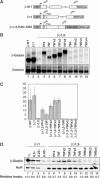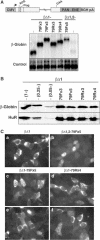A Kaposi's sarcoma virus RNA element that increases the nuclear abundance of intronless transcripts
- PMID: 15861127
- PMCID: PMC1142595
- DOI: 10.1038/sj.emboj.7600662
A Kaposi's sarcoma virus RNA element that increases the nuclear abundance of intronless transcripts
Abstract
The Kaposi's sarcoma-associated herpesvirus produces a 1077 nucleotide noncoding, polyadenylated, exclusively nuclear RNA called PAN that is highly expressed in lytically infected cells. We report that PAN contains a novel post-transcriptional element essential for its abundant accumulation. The element, PAN-ENE (PAN RNA expression and nuclear retention element), increases the efficiency of 3'-end formation in vivo and is sufficient to enhance RNA abundance from an otherwise inefficiently expressed intronless beta-globin construct. The PAN-ENE does not concomitantly increase the production of encoded protein. Rather, it retains the unspliced beta-globin mRNA in the nucleus. Tethering of export factors can override the nuclear retention of the PAN-ENE, supporting a mechanism whereby the PAN-ENE blocks assembly of an export-competent mRNP. The activities of the PAN-ENE are specific to intronless constructs, since inserting the PAN-ENE into a spliced beta-globin construct has no effect on mRNA abundance and does not affect localization. This is the first characterization of a cis-acting element that increases RNA abundance of intronless transcripts but inhibits assembly of an export-competent mRNP.
Figures








Similar articles
-
Kaposi's sarcoma-associated herpesvirus ORF57 protein binds and protects a nuclear noncoding RNA from cellular RNA decay pathways.PLoS Pathog. 2010 Mar 5;6(3):e1000799. doi: 10.1371/journal.ppat.1000799. PLoS Pathog. 2010. PMID: 20221435 Free PMC article.
-
Recruitment of the complete hTREX complex is required for Kaposi's sarcoma-associated herpesvirus intronless mRNA nuclear export and virus replication.PLoS Pathog. 2008 Oct;4(10):e1000194. doi: 10.1371/journal.ppat.1000194. Epub 2008 Oct 31. PLoS Pathog. 2008. PMID: 18974867 Free PMC article.
-
Kaposi's Sarcoma-Associated Herpesvirus mRNA Accumulation in Nuclear Foci Is Influenced by Viral DNA Replication and Viral Noncoding Polyadenylated Nuclear RNA.J Virol. 2018 Jun 13;92(13):e00220-18. doi: 10.1128/JVI.00220-18. Print 2018 Jul 1. J Virol. 2018. PMID: 29643239 Free PMC article.
-
Virus-mediated mRNA decay by hyperadenylation.Genome Biol. 2009;10(8):234. doi: 10.1186/gb-2009-10-8-234. Epub 2009 Aug 11. Genome Biol. 2009. PMID: 19678916 Free PMC article. Review.
-
The challenge of viral snRNPs.Cold Spring Harb Symp Quant Biol. 2006;71:377-84. doi: 10.1101/sqb.2006.71.057. Cold Spring Harb Symp Quant Biol. 2006. PMID: 17381320 Review.
Cited by
-
Methyltransferase-like protein 16 binds the 3'-terminal triple helix of MALAT1 long noncoding RNA.Proc Natl Acad Sci U S A. 2016 Dec 6;113(49):14013-14018. doi: 10.1073/pnas.1614759113. Epub 2016 Nov 21. Proc Natl Acad Sci U S A. 2016. PMID: 27872311 Free PMC article.
-
Redefining the genetics of murine gammaherpesvirus 68 via transcriptome-based annotation.Cell Host Microbe. 2010 Jun 25;7(6):516-26. doi: 10.1016/j.chom.2010.05.005. Cell Host Microbe. 2010. PMID: 20542255 Free PMC article.
-
Delineation of a core RNA element required for Kaposi's sarcoma-associated herpesvirus ORF57 binding and activity.Virology. 2011 Oct 25;419(2):107-16. doi: 10.1016/j.virol.2011.08.006. Epub 2011 Sep 1. Virology. 2011. PMID: 21889182 Free PMC article.
-
Structural insights into the stabilization of MALAT1 noncoding RNA by a bipartite triple helix.Nat Struct Mol Biol. 2014 Jul;21(7):633-40. doi: 10.1038/nsmb.2844. Epub 2014 Jun 22. Nat Struct Mol Biol. 2014. PMID: 24952594 Free PMC article.
-
Viral non-coding RNAs: Stealth strategies in the tug-of-war between humans and herpesviruses.Semin Cell Dev Biol. 2021 Mar;111:135-147. doi: 10.1016/j.semcdb.2020.06.015. Epub 2020 Jul 3. Semin Cell Dev Biol. 2021. PMID: 32631785 Free PMC article. Review.
References
-
- Andersen AA, Panning B (2003) Epigenetic gene regulation by noncoding RNAs. Curr Opin Cell Biol 15: 281–289 - PubMed
Publication types
MeSH terms
Substances
Grants and funding
LinkOut - more resources
Full Text Sources
Other Literature Sources
Medical

